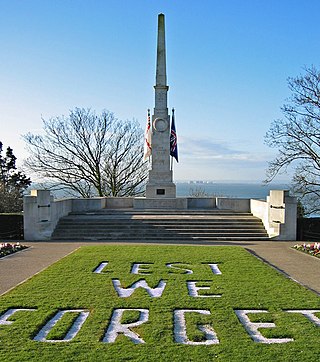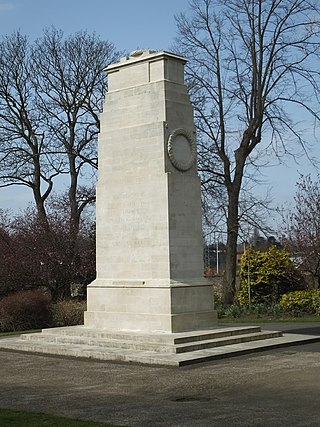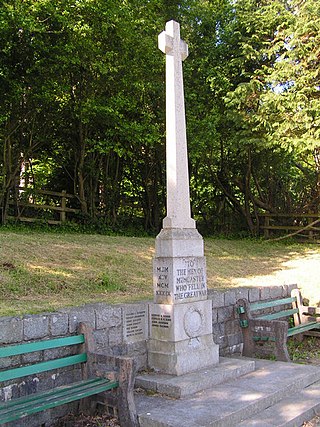
Rochdale Cenotaph is a First World War memorial on the Esplanade in Rochdale, Greater Manchester, in the north west of England. Designed by Sir Edwin Lutyens, it is one of seven memorials in England based on his Cenotaph in London and one of his more ambitious designs. The memorial was unveiled in 1922 and consists of a raised platform bearing Lutyens' characteristic Stone of Remembrance next to a 10-metre (33 ft) pylon topped by an effigy of a recumbent soldier. A set of painted stone flags surrounds the pylon.

The South African War Memorial is a First World War memorial in Richmond Cemetery in the London Borough of Richmond upon Thames. Designed by architect Sir Edwin Lutyens, the memorial is in the form of a cenotaph, similar to that on Whitehall, also by Lutyens. It was commissioned by the South African Hospital and Comforts Fund Committee to commemorate the 39 South African soldiers who died of their wounds at a military hospital in Richmond Park during the First World War. The memorial was unveiled by General Jan Smuts in 1921 and was the focus of pilgrimages from South Africa through the 1920s and 1930s, after which it was largely forgotten until the 1980s when the Commonwealth War Graves Commission took responsibility for its maintenance. It has been a grade II listed building since 2012.

The Devon County War Memorial is a First World War memorial, designed by Sir Edwin Lutyens and situated on Cathedral Green in Exeter, the county town of Devon, in the south west of England. It is one of fifteen War Crosses designed by Lutyens with similar characteristics, and one of two to serve as a civic memorial in a city. The first proposal for the county's war memorial was to complete the construction of a cloister at Exeter Cathedral to be dedicated to Devon's war dead, but this scheme was abandoned due to lack of funds. After considering multiple proposals, the Devon County War Memorial Committee commissioned Lutyens to design a War Cross instead. The committee chose to site the memorial on the green of Exeter Cathedral after scouting several locations. A war memorial for Exeter itself was being considered concurrently, but the committees for the two projects failed to work together, resulting in two separate memorials—the county memorial by the cathedral and Exeter City War Memorial in Northernhay Gardens.

The York City War Memorial is a First World War memorial designed by Sir Edwin Lutyens and located in York in the north of England. Proposals for commemorating York's war dead originated in 1919 but proved controversial. Initial discussions focused on whether a memorial should be a monument or should take on some utilitarian purpose. Several functional proposals were examined until a public meeting in January 1920 opted for a monument. The city engineer produced a cost estimate and the war memorial committee engaged Lutyens, who had recently been commissioned by the North Eastern Railway (NER) to design their own war memorial, also to be sited in York.

Southend-on-Sea War Memorial, or Southend War Memorial, is a First World War memorial in Southend-on-Sea, Essex, in south-eastern England. It was designed by Sir Edwin Lutyens and unveiled in 1921. Southend-on-Sea is a seaside resort famous for its pleasure pier, which was used by the military during the First World War. The town was a stopping point for soldiers en route to the front and, as the war drew on, several buildings in Southend were converted into hospitals.

Busbridge War Memorial is a First World War memorial in the churchyard of St John's Church in village of Busbridge in Surrey, south-eastern England. Designed by Sir Edwin Lutyens, it is Grade II* listed.

The British Thomson-Houston Company War Memorial is a First World War memorial in Rugby, Warwickshire, in the West Midlands of England. It was erected by the British Thomson-Houston Company in memory of the firm's employees who left to fight in the First World War and were killed in service. Designed by Sir Edwin Lutyens, it was unveiled in 1921 and is now a grade II* listed building.

The Queen's Own Royal West Kent Regiment Cenotaph is a First World War memorial dedicated to members of the Queen's Own Royal West Kent Regiment and located in Maidstone in Kent, south-eastern England. Unveiled in 1921, the memorial was designed by Sir Edwin Lutyens following his design for the Cenotaph on Whitehall in London and is today a grade II* listed building.
The Royal Berkshire Regiment War Memorial or Royal Berkshire Regiment Cenotaph is a First World War memorial dedicated to members of the Royal Berkshire Regiment and located in Brock Barracks in Reading, Berkshire, in south-east England. Unveiled in 1921, the memorial was designed by Sir Edwin Lutyens, based on his design for the Cenotaph on Whitehall in London, and is today a grade II* listed building.

The Oxfordshire and Buckinghamshire Light Infantry War Memorial is a First World War memorial in the Cowley area of Oxford in southern England. Designed by Sir Edwin Lutyens, it commemorates men of the Oxfordshire and Buckinghamshire Light Infantry killed in the conflict; it was unveiled on Armistice Day, 11 November 1923, and has been a grade II listed building since 1972.

The Leeds Rifles War Memorial is a First World War memorial outside Leeds Minster on Kirkgate in Leeds, West Yorkshire in northern England. The memorial was designed by Sir Edwin Lutyens, one of 15 instances of his War Cross and the only one commissioned by a regiment. The memorial, dedicated to members of the Leeds Rifles who fell in the First World War, was unveiled on Remembrance Sunday, 13 November 1921, and is today a grade II listed building.

Fordham War Memorial is a First World War memorial in the village of Fordham in Cambridgeshire in eastern England. The memorial was designed by Sir Edwin Lutyens with sculpture by Sir George Frampton and closely resembles Hove War Memorial in East Sussex, which was also a collaboration between Lutyens and Frampton. It was unveiled in 1921 and is today a grade II listed building.

Miserden War Memorial is a First World War memorial in the village of Miserden, near Stroud, in Gloucestershire, south-western England. The memorial, designed by Sir Edwin Lutyens, is today a grade II listed building.

Abinger Common War Memorial is a First World War memorial in the village of Abinger Common in Surrey, south-eastern England. The memorial was destroyed by a German bomb during the Second World War and rebuilt in the late 1940s. One of 15 war crosses by Sir Edwin Lutyens, it is a grade II listed building.

Hartburn War Memorial is a First World War Memorial in the village of Hartburn, Northumberland, in the north-east of England. The memorial, designed by Sir Edwin Lutyens, was unveiled in 1921 and is today a grade II listed building.

King's Somborne War Memorial is a First World War memorial in the village of King's Somborne in Hampshire in southern England. The memorial was designed by Sir Edwin Lutyens and unveiled in 1921; it is a grade II listed building.

Stockbridge War Memorial is a First World War memorial in the town of Stockbridge in Hampshire in southern England. The memorial was designed by Sir Edwin Lutyens and unveiled in 1921; it is a grade II listed building.

Muncaster War Memorial is a First World War memorial in the parish of Muncaster on the west coast of Cumbria in the far north-west of England. The memorial is one of fifteen War Crosses designed by Sir Edwin Lutyens; it was unveiled in 1922 and is now a grade II listed building.

Wargrave War Memorial is First World War memorial in the village of Wargrave in Berkshire, south-eastern England. Designed by Sir Edwin Lutyens, the memorial was unveiled in 1922 and is today a grade II listed building.

Sandhurst War Memorial is a First World War memorial in the village of Sandhurst in Kent, south-eastern England, close to the border with East Sussex. The memorial is one of fifteen War Crosses by Sir Edwin Lutyens and arguably the one with the most elaborate setting. It was unveiled in 1923 and is today a grade II listed building.



















